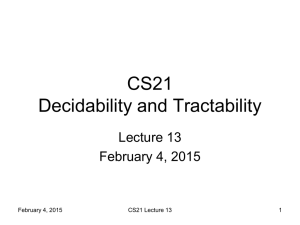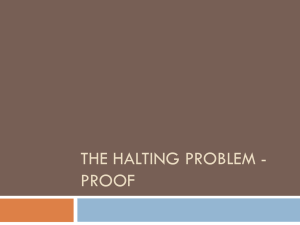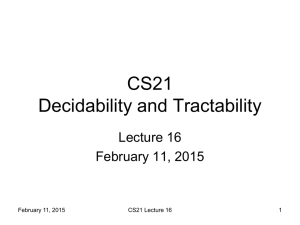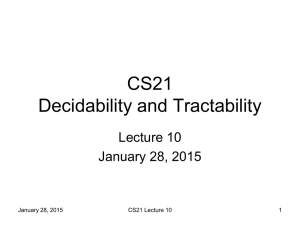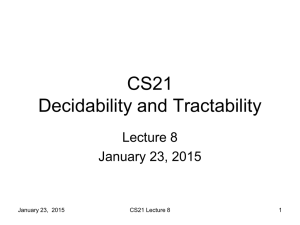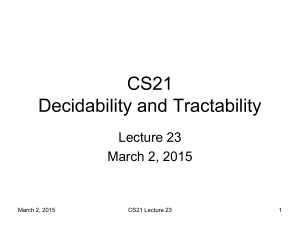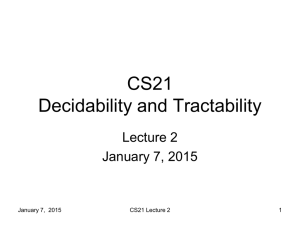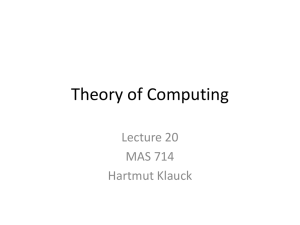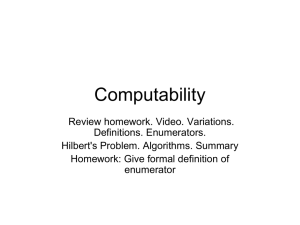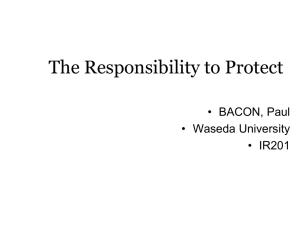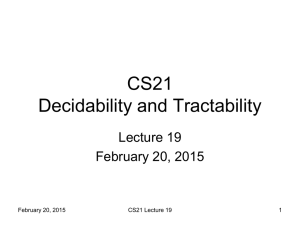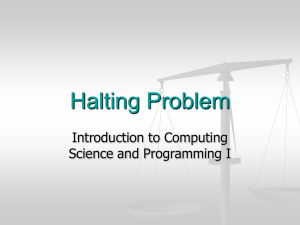ppt - Computing + Mathematical Sciences
advertisement
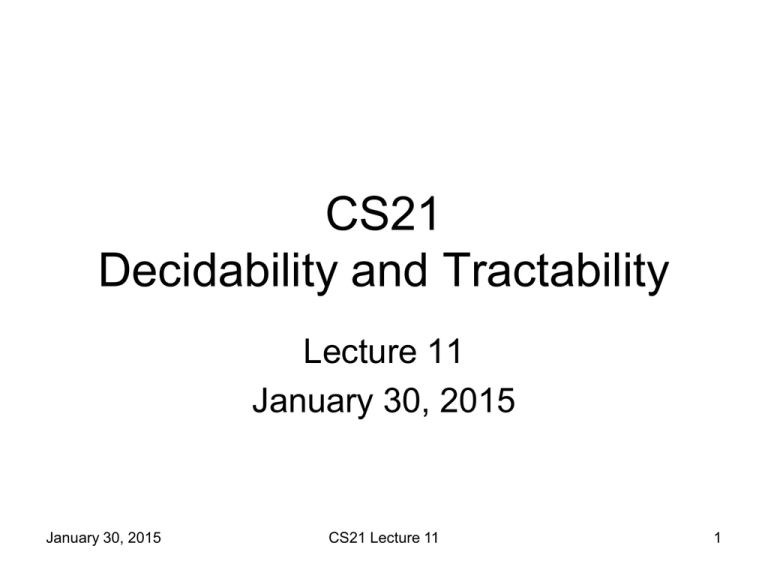
CS21
Decidability and Tractability
Lecture 11
January 30, 2015
January 30, 2015
CS21 Lecture 11
1
Outline
•
•
•
•
decidable, RE, co-RE languages
the Halting Problem
reductions
many-one reductions
January 30, 2015
CS21 Lecture 11
2
non-RE languages
Theorem: there exist languages that are not
Recursively Enumerable.
Proof outline:
– the set of all TMs is countable
– the set of all languages is uncountable
– the function L:{TMs} →{languages} cannot be
onto
January 30, 2015
CS21 Lecture 11
3
non-RE languages
• Lemma: the set of all TMs is countable.
• Proof:
– each TM M can be described by a finitelength string <M>
– can enumerate these strings, and give the
natural bijection with N
January 30, 2015
CS21 Lecture 11
4
non-RE languages
• Lemma: the set of all languages is
uncountable
• Proof:
– fix an enumeration of all strings s1, s2, s3, …
(for example, lexicographic order)
– a language L is described by its characteristic
vector L whose ith element is 0 if si is not in L
and 1 if si is in L
January 30, 2015
CS21 Lecture 11
5
non-RE languages
– suppose the set of all languages is countable
– list characteristic vectors of all languages
according to the bijection f:
n
f(n)
_
1
0101010…
2
1010011…
3
1110001…
4
0100011…
…
January 30, 2015
CS21 Lecture 11
6
non-RE languages
– suppose the set of all languages is countable
– list characteristic vectors of all languages
according to the bijection f:
n
f(n)
1
0101010…
2
1010011…
3
1110001…
4
0100011…
…
January 30, 2015
_
set x = 1101…
where ith digit ≠ ith digit of f(i)
x cannot be in the list!
therefore, the language with
characteristic vector x is not
in the list
CS21 Lecture 11
7
So far…
{anbn : n ≥ 0 }
some language
decidable
all languages
regular
languages
context free
languages
RE
{anbncn : n ≥ 0 }
• This language might be an esoteric,
artificially constructed one. Do we care?
• We will show a natural undecidable L next.
January 30, 2015
CS21 Lecture 11
8
The Halting Problem
• Definition of the “Halting Problem”:
HALT = { <M, x> : TM M halts on input x }
• HALT is recursively enumerable.
– proof?
• Is HALT decidable?
January 30, 2015
CS21 Lecture 11
9
The Halting Problem
Theorem: HALT is not decidable
(undecidable).
Proof:
– Suppose TM H decides HALT
– Define new TM H’: on input <M>
• if H accepts <M, <M>> then loop
• if H rejects <M, <M>> then halt
January 30, 2015
CS21 Lecture 11
10
The Halting Problem
Proof:
– define new TM H’: on input <M>
• if H accepts <M, <M>> then loop
• if H rejects <M, <M>> then halt
– consider H’ on input <H’>:
• if it halts, then H rejects <H’, <H’>>, which implies
it cannot halt
• if it loops, then H accepts <H’, <H’>> which implies
it must halt
– contradiction.
January 30, 2015
CS21 Lecture 11
11
The Halting Problem
box
(M, x):
does M
halt on
x?
inputs
Y
Turing
Machines
n
Y
n
n
Y
n
H’ :
January 30, 2015
n Y n Y Y n Y
CS21 Lecture 11
The existence of
H which tells us
yes/no for each
box allows us to
construct a TM H’
that cannot be in
the table.
12
So far…
{anbn : n ≥ 0 }
some language
decidable
all languages
regular
languages
context free
languages
{anbncn : n ≥ 0 }
RE
HALT
• Can we exhibit a natural language that is
non-RE?
January 30, 2015
CS21 Lecture 11
13
RE and co-RE
• The complement of a RE language is
called a co-RE language
{anbn : n ≥ 0 }
decidable
co-RE
some language
all languages
regular
languages
context free
languages
RE
{anbncn : n ≥ 0 }
January 30, 2015
CS21 Lecture 11
HALT
14
RE and co-RE
Theorem: a language L is decidable if and
only if L is RE and L is co-RE.
Proof:
() we already know decidable implies RE
– if L is decidable, then complement of L is
decidable by flipping accept/reject.
– so L is in co-RE.
January 30, 2015
CS21 Lecture 11
15
RE and co-RE
Theorem: a language L is decidable if and
only if L is RE and L is co-RE.
Proof:
() we have TM M that recognizes L, and TM
M’ recognizes complement of L.
– on input x, simulate M, M’ in parallel
– if M accepts, accept; if M’ accepts, reject.
January 30, 2015
CS21 Lecture 11
16
A natural non-RE language
Theorem: the complement of HALT is not
recursively enumerable.
Proof:
– we know that HALT is RE
– suppose complement of HALT is RE
– then HALT is co-RE
– implies HALT is decidable. Contradiction.
January 30, 2015
CS21 Lecture 11
17
Summary
co-HALT
{anbn : n ≥ 0 }
co-RE
decidable
some language
all languages
regular
languages
context free
languages
RE
{anbncn : n ≥ 0 }
HALT
Main point: some problems have no
algorithms, HALT in particular.
January 30, 2015
CS21 Lecture 11
18
Reductions
• Given a new problem NEW, want to
determine if it is easy or hard
– right now, easy typically means decidable
– right now, hard typically means undecidable
• One option:
– prove from scratch that the problem is
decidable, or
– prove from scratch that the problem is
undecidable (dream up a diag. argument)
January 30, 2015
CS21 Lecture 11
19
Reductions
• A better option:
– to prove NEW is decidable, show how to
transform it into a known decidable problem
OLD so that solution to OLD can be used to
solve NEW.
– to prove NEW is undecidable, show how to
transform a known undecidable problem OLD
into NEW so that solution to NEW can be
used to solve OLD.
• called a reduction
January 30, 2015
CS21 Lecture 11
20
Reductions
Reductions are one of the most important
and widely used techniques in theoretical
Computer Science.
• especially for proving problems “hard”
– often difficult to do “from scratch”
– sometimes not known how to do from scratch
– reductions allow proof by giving an algorithm
to perform the transformation
January 30, 2015
CS21 Lecture 11
21
Example reduction
• Try to prove undecidable:
ATM = {<M, w> : M accepts input w}
• We know this language is undecidable:
HALT = {<M, w> : M halts on input w}
• Idea:
reduction
– suppose ATM is decidable
– show that we can use ATM to decide HALT
– conclude HALT is decidable. Contradiction.
January 30, 2015
CS21 Lecture 11
22
Example reduction
• How could we use procedure that decides
ATM to decide HALT?
– given input to HALT: <M, w>
• Some things we can do:
– check if <M, w> ATM
– construct another TM M’ and check if
<M’, w> ATM
January 30, 2015
CS21 Lecture 11
23
Example reduction
• Deciding HALT using a procedure that
decides ATM (“reducing HALT to ATM”).
– on input <M, w>
– check if <M, w> ATM
• if yes, the M halts on w; ACCEPT
• if no, then M either rejects w or it loops on w
– construct M’ by swapping qaccept/qreject in M
– check if <M’, w> ATM
• if yes, then M’ accepts w, so M rejects w; ACCEPT
• if no, then M neither accepts nor rejects w; REJECT
January 30, 2015
CS21 Lecture 11
24
Example reduction
• Preceding reduction proved:
Theorem: ATM is undecidable.
Proof (recap):
– suppose ATM is decidable
– we showed how to use ATM to decide HALT
– conclude HALT is decidable. Contradiction.
January 30, 2015
CS21 Lecture 11
25
Another example
• Try to prove undecidable:
ETM = {<M> : L(M) = Ø}
• which problem should we reduce from?
– HALT = {<M, w> : M halts on input w}
– ATM = {<M, w> : M accepts input w}
• Some things we can do:
– check if <M> ETM
– construct another TM M’ and check if
<M’> ETM
January 30, 2015
CS21 Lecture 11
26
Another example
• We are given input <M, w>
• We want to use a procedure that decides
ETM to decide if <M, w> ATM
• Idea:
– check if <M> ETM
– if not?
– helpful if could make M reject everything
except possibly w.
January 30, 2015
CS21 Lecture 11
27
Another example
• Construct TM M’:
Is this OK?
finite # of
states?
– on input x, if x w, then reject
– else simulate M on x, and accept if M does.
• on input <M, w>
– construct M’ from description of M
– check if M’ ETM
• if no, M must accept w; ACCEPT
• if yes, M cannot accept w; REJECT
January 30, 2015
CS21 Lecture 11
28
Another example
• Preceding reduction proved:
Theorem: ETM is undecidable.
Proof (recap):
– suppose ETM is decidable
– we showed how to use ETM to decide ATM
– conclude ATM is decidable. Contradiction.
January 30, 2015
CS21 Lecture 11
29
Definition of reduction
• Can you reduce co-HALT to HALT?
• We know that HALT is RE
• Does this show that co-HALT is RE?
– recall, we showed co-HALT is not RE
• our current notion of reduction cannot
distinguish complements
January 30, 2015
CS21 Lecture 11
30
Definition of reduction
• More refined notion of reduction:
– “many-one” reduction (commonly)
– “mapping” reduction (book)
A
yes
no
January 30, 2015
f
f
B
yes
no
CS21 Lecture 11
reduction from
language A to
language B
31
Definition of reduction
A
yes
no
f
f
B
yes
no
• function f should be computable
Definition: f : Σ*→ Σ* is computable if there
exists a TM Mf such that on every wΣ* Mf
halts on w with f(w) written on its tape.
January 30, 2015
CS21 Lecture 11
32
Definition of reduction
• Notation: “A many-one reduces to B” is
written
A ≤m B
– “yes maps to yes and no maps to no” means:
w A maps to f(w) B & w A maps to f(w) B
• B is at least as “hard” as A
– more accurate: B at least as “expressive” as A
January 30, 2015
CS21 Lecture 11
33
